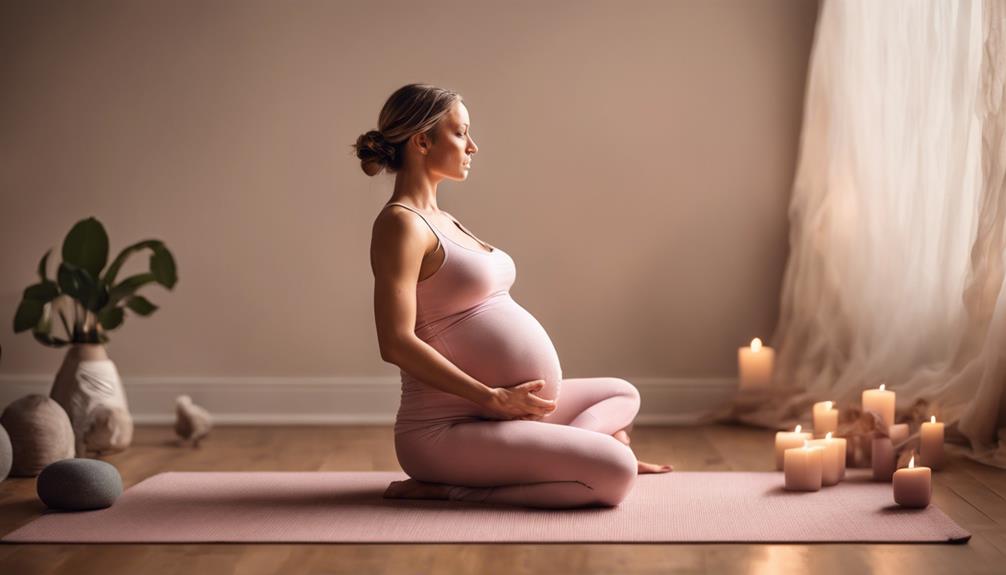As we face the difficulties of the third trimester, making sure we stay safe and comfortable while leaning over for our baby is as crucial as locating a needle in a haystack.
The strain on our bodies is undeniable, but with the right techniques, we can gracefully overcome this hurdle.
Stay tuned as we unravel the secrets to bending safely during this delicate period, providing you with the tools to protect both yourself and your precious baby.
Key Takeaways
- Master safe bending techniques for maternal and baby well-being.
- Avoid incorrect postures to prevent risks and discomfort.
- Use furniture for stability and seek professional help if needed.
- Prioritize maternal and fetal health by consulting healthcare providers.
Importance of Safe Bending Techniques
Importantly, mastering safe bending techniques is paramount to safeguarding the well-being of both the mother and the baby during the third trimester of pregnancy. Proper bending not only prevents back pain but also reduces strain on the abdomen muscles, promoting a more comfortable pregnancy experience. When bending, remember to keep your back straight, bend at the knees instead of the waist, and spread your knees apart for better balance. By distributing your weight evenly, you can avoid falls and potential injuries. Using furniture or support for stability while bending over can further minimize any risks.
Additionally, seeking professional assistance if you experience any pain or discomfort during bending is essential for ensuring both maternal and fetal health. By being mindful of your bending posture and implementing these techniques, you can protect yourself and your baby, making the third trimester a more manageable and safer period.
Risks of Incorrect Bending Postures
During the third trimester of pregnancy, incorrect bending postures can pose significant risks to both the expectant mother and the developing baby. Poor bending techniques can strain back muscles, leading to lower back pain and discomfort, especially with the added weight of the growing baby.
Improper bending postures may also compress blood vessels, disrupting proper blood flow and potentially causing dizziness or lightheadedness. Sharp pain, particularly in the back, hips, and legs, can result from bending incorrectly due to the strain on ligaments and muscles. Maintaining important posture and avoiding bending at the waist can help prevent these issues.
Additionally, the shifting center of gravity during pregnancy makes balance and coordination more challenging, increasing the risk of falls when bending incorrectly. It's vital to be mindful of proper bending techniques, such as bending at the knees and keeping a straight back, to minimize the potential risks associated with bending during the third trimester.
Tips for Proper Bending in Pregnancy
Properly bending during pregnancy is crucial for maintaining comfort and safety for both the mother and the baby. To guarantee proper body mechanics and reduce strain, it's important to follow some key tips for bending in the third trimester. Here are some practical guidelines to help you bend safely:
| Tips for Proper Bending in Pregnancy | |
|---|---|
| Keep your back straight | Bend at the knees instead of the waist to maintain good posture and balance |
| Use furniture or support | Prevent falls and injuries by using furniture for stability, especially as your belly grows |
| Seek professional help | If you experience pain or discomfort while bending, consult a healthcare provider for guidance and support |
Common Bending-Related Discomforts
When experiencing discomfort related to bending during the third trimester of pregnancy, it's essential to recognize the impact of ligament stretching and increased pressure on the body.
Ligaments in the uterus undergo significant stretching to accommodate the growing baby, leading to discomfort when bending over. This stretching, combined with the increased pressure on the back, hips, and legs, can make simple tasks like bending down more challenging during this stage of pregnancy.
Sharp pain around the low belly and groin may signal round ligament pain, a common discomfort experienced while bending over. To alleviate these issues, it's important to practice proper bending techniques and use support when necessary to prevent injuries and reduce discomfort.
If persistent pain or discomfort while bending over is experienced, consulting a healthcare provider is crucial for both maternal and fetal health. Remember, taking care of yourself and seeking help when needed is essential during this delicate time.
When to Avoid Bending in Pregnancy
Under what circumstances should pregnant individuals consider avoiding bending throughout their pregnancy? High-risk pregnancies, a history of complications, and preterm labor risks are key factors that may warrant bending restrictions. Conditions like placenta previa or abruption require pregnant individuals to refrain from bending over to safeguard maternal and fetal health. Any indication of discomfort, pain, or unusual symptoms should not be ignored, prompting pregnant individuals to avoid bending and seek medical advice promptly. Consulting a healthcare provider is crucial to assess the need for bending restrictions during pregnancy, especially when experiencing round ligament pain or other concerning symptoms. Prioritizing maternal and fetal health by adhering to medical advice on bending limitations is essential for a safe and healthy pregnancy journey.
| Factors Requiring Bending Restrictions | Examples | Importance |
|---|---|---|
| High-risk pregnancies | Gestational hypertension | Safeguard maternal well-being |
| History of complications | Previous preterm birth | Reduce preterm labor risks |
| Unusual symptoms | Vaginal bleeding | Prompt medical evaluation |
Frequently Asked Questions
Can Bending Over Hurt Baby Third Trimester?
Bending over in the third trimester won't hurt the baby directly. The amniotic fluid protects them. Proper bending techniques can ease discomfort from your growing bump. Remember to ask for help and rest, ensuring safety for you and baby.
What Kind of Bending Is Bad for Pregnancy?
Bending during pregnancy needs caution. Twisting strains muscles, sudden moves may cause balance issues. Prolonged bending may lead to discomfort. Squatting with support is wise. Protecting the baby is key in avoiding harm.
Can I Hurt My Baby by Pressing on My Stomach Third Trimester?
Pressing on the stomach in the third trimester won't hurt the baby; amniotic fluid provides protection. The baby is safe within the womb, shielded from external pressures. Gentle pressure is unlikely to harm.
Am I Squishing My Baby When I Sleep on My Side?
Sleeping on our side during pregnancy is safe and recommended for better blood flow to the baby. It prevents squishing the baby by avoiding compression of essential blood vessels. Using pillows for support enhances comfort and safety.
Conclusion
To sum up, prioritizing safe bending techniques during the third trimester is essential for the well-being of both you and your baby. Did you know that up to 50% of pregnant women experience lower back pain due to incorrect bending postures?
By following proper guidelines and seeking assistance when needed, you can reduce the risk of injuries and discomfort, ensuring a smoother pregnancy journey. Remember to listen to your body, rest when needed, and consult your healthcare provider for personalized advice.









